AP Psychology Unit 1 Biological Bases of Behavior
1/123
Earn XP
Description and Tags
Vocabulary from Unit 1 of AP Psychology (Biological Bases of Behavior)
Name | Mastery | Learn | Test | Matching | Spaced |
|---|
No study sessions yet.
124 Terms
Phrenology
The belief that the bumps of the skull can predict mental ability and character traits.
Franz Gall suggested this in the 1800s. Bumps represented having that mental ability, and dips meant you didn’t have it.
Sensory Neurons
These carry information from the body’s tissues and organs to the central nervous system.
Interneuron
Also known as “relay neurons”, these are in the spinal cord only and link the motor neurons with the sensory neurons. They also make sense of what is going on in the body. They are within the brain and spinal cord that communicate internally and intervene between the sensory inputs and the motor outputs.
Reflexes!
Motor Neurons
These carry instructions from the central nervous system to muscles and glands.
Glial Cells
These provide nutrition and insulation for neurons. It is what makes up the myelin sheaths.
Cell Body
This is the life supported center of the neuron.
Dendrites
These are branching extensions at the cell body. They receive messages from other neurons.
Axon
This is a long single extension of a neuron, covered with a myelin sheath.
Myelin Sheath
This insulates and speeds up messages through neurons. It does not regulate the release of neurotransmitters.
Terminal Branches of Axon
These are branched endings of an axon that transmit messages to other neurons.
Action Potential
A charge that travels down an axon, generated by the movement of positively charged atoms (Sodium and Potassium) in and out of the axon.
Polarization (resting potential)
This is when negative ions enter the neuron making it less prone to firing an action potential.
Depolarization (action potential)
This is when positive ions enter the neuron, making it more prone to firing an action potential.
Hyperpolariztion
This is the opposite of depolarization. It makes a neuron less prone to firing. It is when the membrane potential becomes more negative at a particular spot on the neuron's membrane, whereas depolarization is when the membrane potential becomes less negative (more positive).
Refractory Period
This is the resting state after firing in which the neuron goes back to its polarized
Synapse
This is the tiny gap between sending and receiving a neuron is called the synaptic gap or cleft.
Re-Uptake
This is when neurotransmitters in the synapse are reabsorbed into the sending neuron through BLANK.
Neurotransmitters
Chemicals which allow the transmission of signals from one neuron to the next across synapses.
Inhibitory Receptors
This reduces the chance that a transfer will occur.
Ex. ACh: A muscle moving chemical. Snake venom blocks ACh resulting in paralysis. (also people who have Alzheimer's disease and Parkinson's disease tend to have low levels of acetylcholine.)
Excitatory Receptors
These are transmitters that make a neuron more likely to fire an action potential. Things such as nicotine, alcohol, and opiates excite transmitters which leads to a happier feeling.
Lock and Key Mechanism
Neurotransmitters bind to the receptors of the receiving neuron by BLANK.
Agonists
BLANK mimic neurotransmitters
Antagonists
BLANK block transmitters.
Depressants
A drug that reduces functional or nervous activity. ex: alcohol, barbiturates, opioids.
Hallucinogens
These are psychedelic drugs that can potentially change the way people see, hear, taste, smell or feel, and also affect mood and thought.
Examples: LSD, marijuana, NDE’s.
Brainstem
This is the oldest part of the brain. It is responsible
for automatic survival functions.
Medulla
This is the base of the brainstem that controls heartbeat and breathing.
Reticular Formation
This is a nerve network that plays an important role in controlling arousal. Its nuclei are found deep within the brainstem.
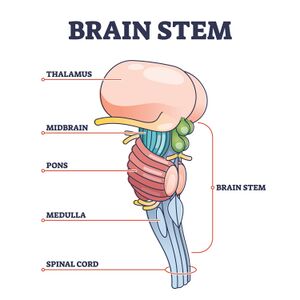
Thalamus
It directs messages (think of a post office to the sensory areas in the cortex. It lies above the brainstem in the middle of the brain.
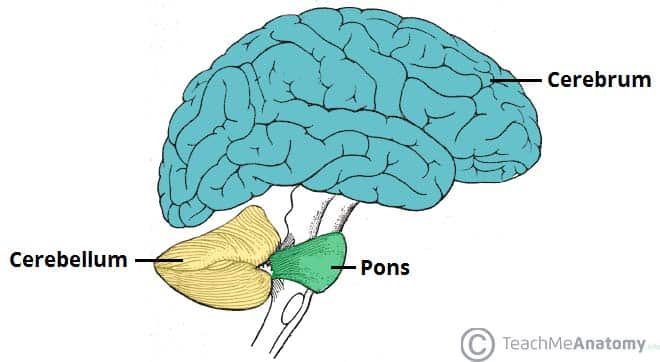
Cerebellum
It helps coordinate voluntary movements and balance. It is the portion of the brain in the back of the head between the cerebrum and the brain stem. The BLANK controls balance for walking and standing, and other complex motor functions. It is between the Brainstem and Cerebrum.
Limbic System
Emotions originate from here. It includes the hippocampus, amygdala, thalamus, and hypothalamus.
Amygdala
This is responsible for emotions of fear and anger. It is located in front of the hippocampus, one on each hemisphere of the brain.
Hippocampus
This part of the brain is involved in memory, learning, and emotion. It’s main job is to hold short term memories and transfer them to long term storage in the brain.
Hypothalamus
This part of the brain keeps the body in homeostasis. It does its job by directly influencing your autonomic nervous system or by managing hormones.
Flight, fight, food, fornication (reproduction).
Cerebral Cortex
The “modern brain”. This is the “rind” that is the body’s ultimate control and information processing center. Also known as “grey matter”. It is made of 4 lobes:
frontal (forehead): voluntary movement, expressive language and for managing higher level executive functions
parietal (top to rear end): sensory perception and integration,
occipital (back head): visual perception, including colour, form and motion
temporal (side of head): processing auditory information and with the encoding of memory.
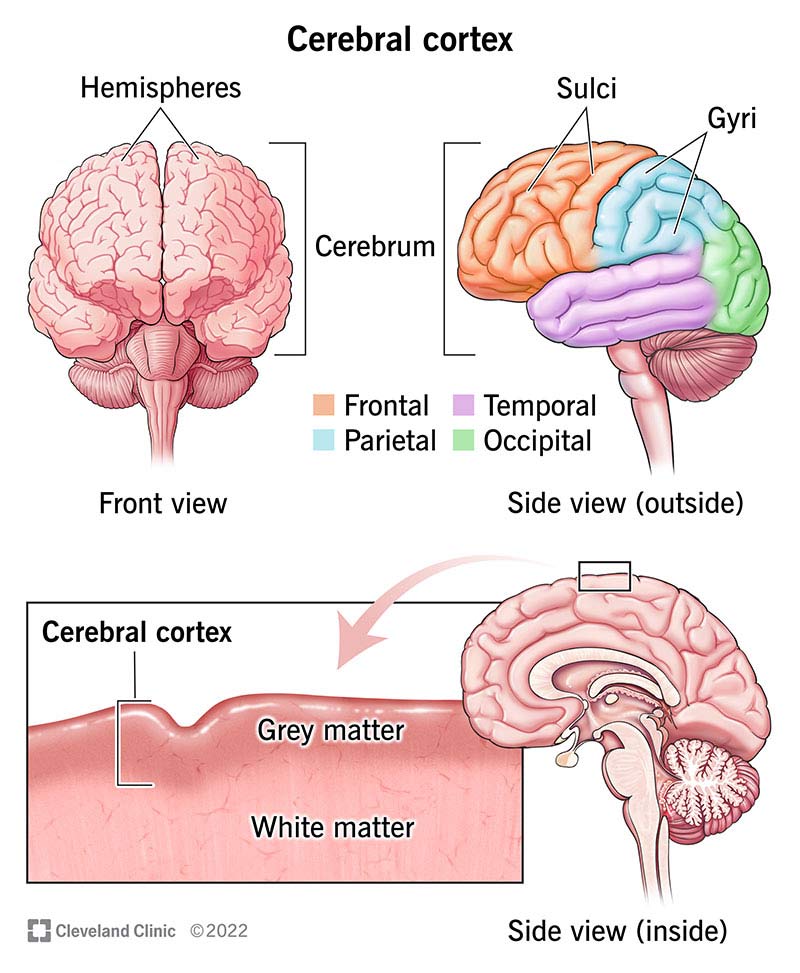
Pre-Frontal Cortex
This is one of the last places in the brain to mature, in the early to mid twenties. This is the front of the front. Helps with: planning, decision making, expression, social behavior.
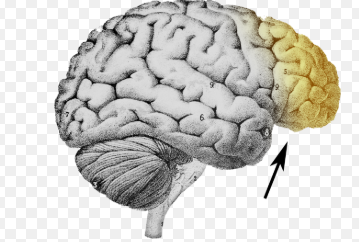
Motor Cortex
This is the area at the rear of the frontal lobes that control voluntary movements. The right BLANK controls the movement of the left side. Like wise, the left hemisphere controls the right side of the body. The two halves communicate with one another through a large, C-shaped structure of white matter and nerve pathways called the corpus callosum.
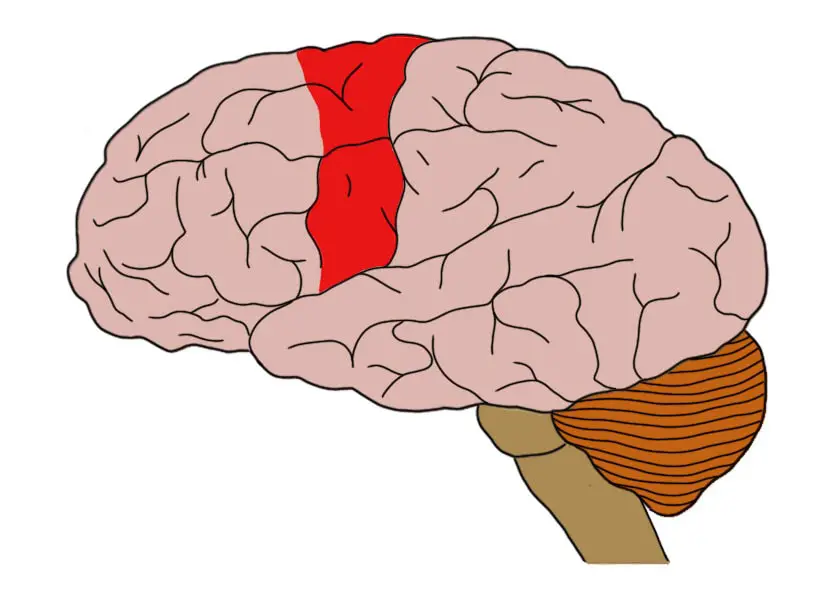
Sensory Cortex
This (parietal cortex) receives information from skin surface and sense organs. The left BLANK senses with the right side of the body and vice versa.
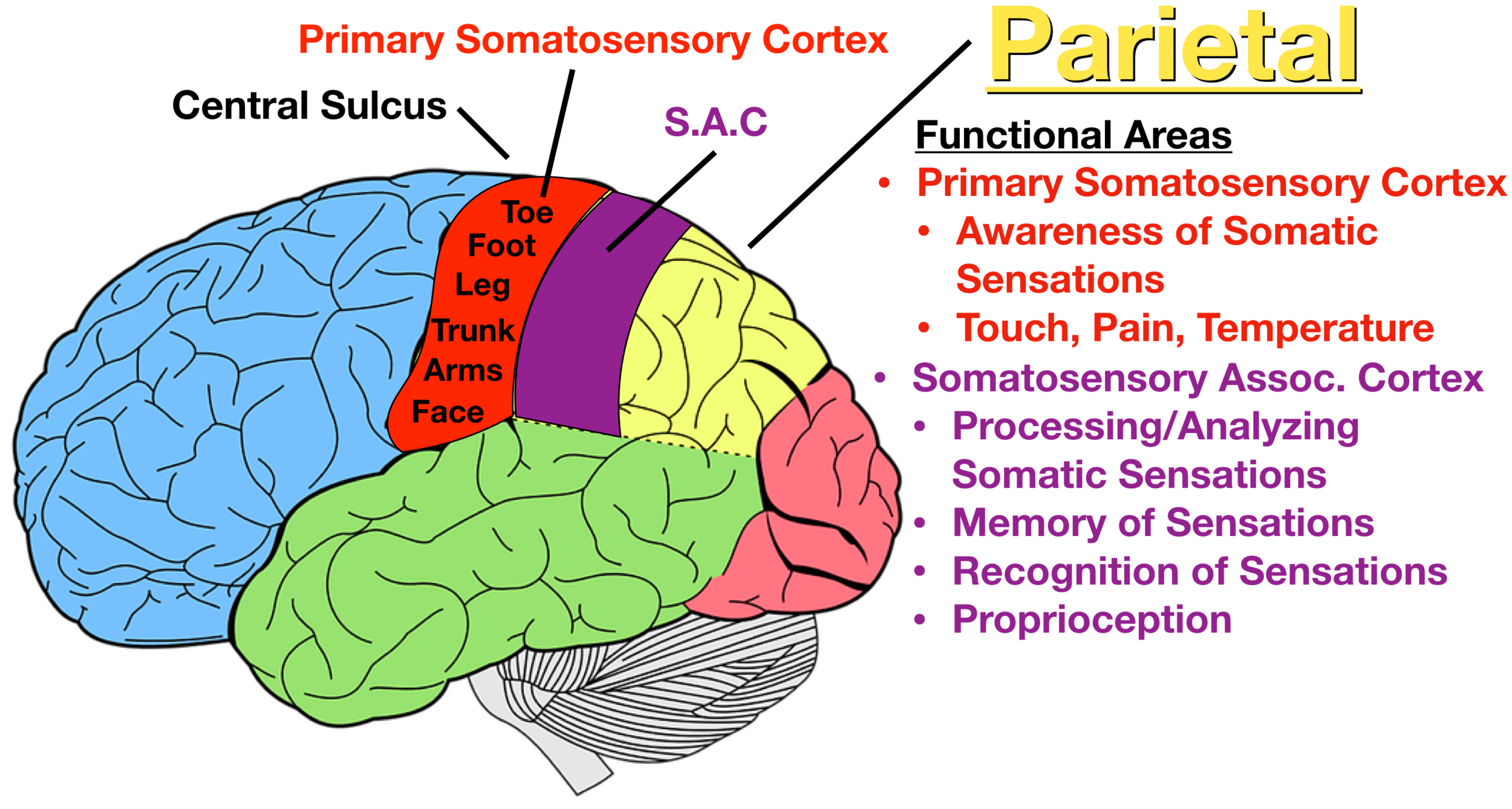
Association Areas
These allow the sensory and motor cortex to communicate with each other. The BLANK for “feel” in blind people is larger in blind people.
Aphasia
This is a language impairment, usually caused by damage to Broca’s area (speaking) or to Wernicke’s area (understanding). Also language is only in the left side of the brain.
Plasticity
This is the brain’s ability to modify itself after some type of injury or illness.
Left Hemisphere
This part of the brain processes reading, writing, speaking, and mathematics. (language)
Right Hemisphere
This part of the brain is more abstract and spatial.
Corpus Callosotomy
This is a surgical procedure used to treat atonic seizures, also called drop attacks, by dividing all or part of the corpus callosum. The corpus callosum is the bundle of nerve fibers that connects the two brain hemispheres. Patients who have had this “split-brain” procedure are able to name objects presented in the right visual field but not in the left visual field.
Annual Cycles
Seasonal variations in appetite, sleep, and mood. Ex. Seasonal Affective Disorder (SAD) is a mood disorder people experience during dark winter months.
28-day cycles
The female menstrual cycle averages 28 days. Not so sure about what sir Chuck wrote for that second sentence.
24-hour Cycle
24- hour cycles of varying alertness (sleep). Circadian Rhythms occur on a 24-hour cycle and include sleep and wakefulness.
Awake and Alert Brain Waves
Beta Waves (15-30 cps)
Awake and Relaxed
Alpha Waves (9-15) cps)
Sleep stages 1 and 2 (spindles)
Theta waves (5-8 cps)
Sleep stages 3 and 4
Delta Waves (2-4 cps)
Stage 5 REM Sleep
Dreaming occurs. Back to Beta waves. “Paradoxical’ sleep.
Somnambulism
Sleepwalking
Night terrors
Intense fear with physiological reactions. “Old Hag” syndrome.
Narcolepsy
Overpowering urge to fall asleep that may occur anytime.
Sleep Apnea
Failure to breathe when asleep. Snoring.
Genes
These are made up of chromosomes and are the biochemical units of heredity. We get 23 chromosomes from both mom and dad, so 46 total. Chromosomes are composed of DNA.
Genome
It is all the genetic information of an organism.
Nervous System
This is the body’s speedy, electrochemical communication system.It is made up of the central and peripheral nervous systems.
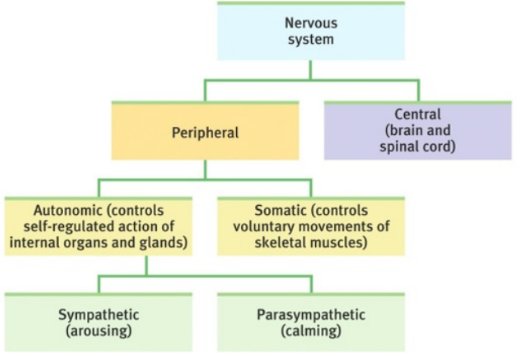
Central Nervous System
This includes the brain and spinal cord.
Peripheral Nervous System
These are the sensory/motor neurons (nerves) that connect the central nervous system to the rest of the body. It includes somatic and autonomic systems.
Somatic Nervous System
Part of the peripheral nervous system, this system voluntarily controls the body’s skeletal muscles. Its also known as the skeletal nervous system.
Autonomic Nervous System
Part of the peripheral nervous system, this system automatically controls the glands and other muscles. (ex. digestion, breathing). This system can be further split into the sympathetic and parasympathetic nervous systems.
Sympathetic Nervous System
Part of the autonomic nervous system, this arouses the body, mobilizing its energy in stressful situations.
Parasympathetic Nervous System
Part of the autonomic nervous system, this system calms the body, conserving its energy.
Endocrine System
This is the body’s “slow” chemical communication system. Communication is carried out by hormones synthesized by a set of glands.
Pituitary
“The Master Gland’ that regulates the other glands.
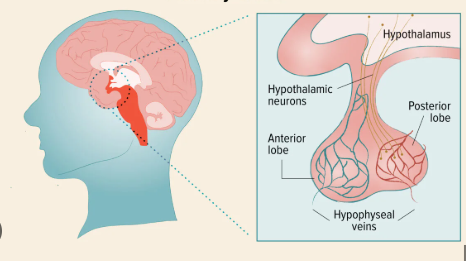
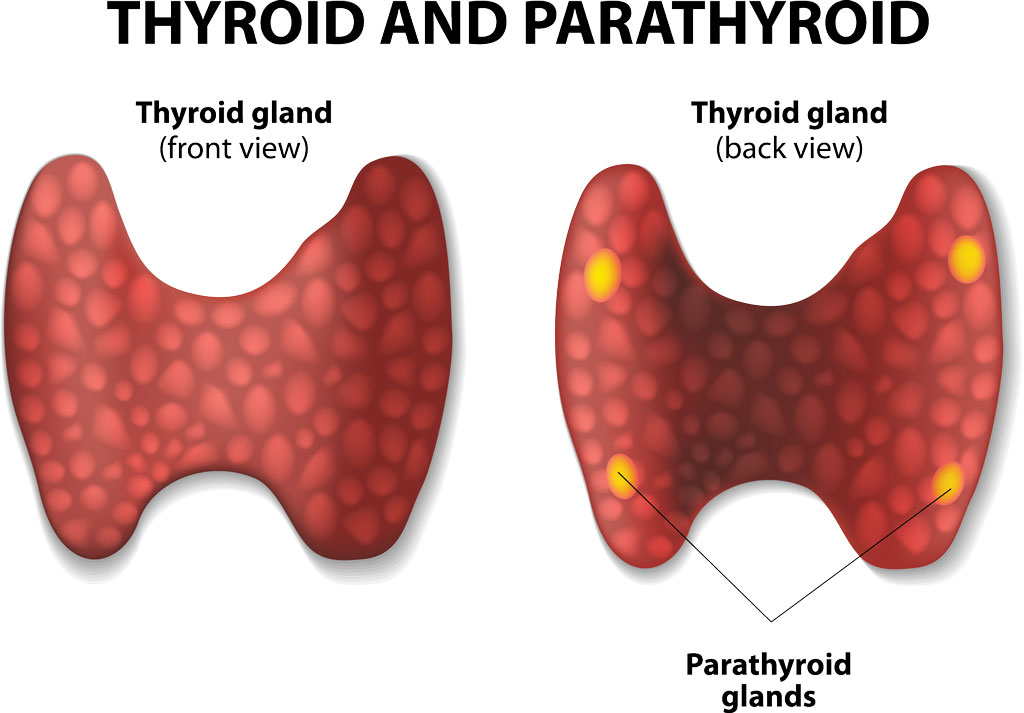
Thyroid
This regulates metabolism and development
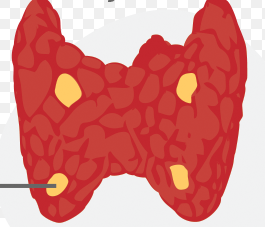
Parathyroid
This regulates calcium and phosphate levels in the blood.
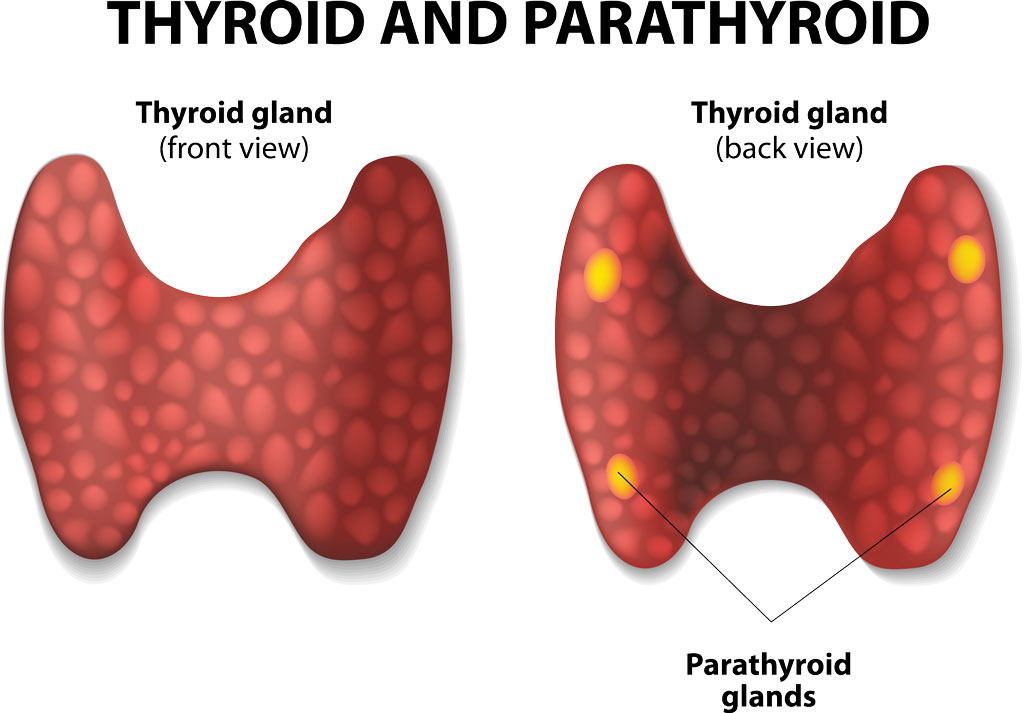
Adrenal
This secretes hormones such as epinephrine and norepinephrine during “Fight or flight” situations.
Pancreas
This is a large gland in the back of your belly. It releases enzymes to help with digestion and hormones to regulate blood sugar.
Gonads
The testes or ovaries, the organ regulates body development and reproductive organs. Testosterone in males and estrogen in females.
Suprachiasmatic Nucleus
This releases melatonin, helping us fall asleep. Bright lights turn it off, keeping us awake.
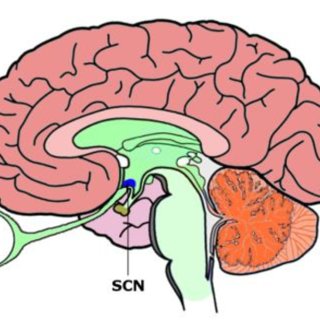
Endorphins
These are neurotransmitters released by the pituitary gland and hypothalamus in the brain. As natural hormones, they can alleviate pain, lower stress, improve mood, and enhance your sense of well-being. The body releases them when you do pleasurable activities like eating and exercising.
Parkinson’s Disease
This disease is marked by the death of dopamine-producing neurons in the brain — specifically in the substantia nigra, a structure deep within a region of the brain called the midbrain.
Dopamine is the chemical messenger that transmits signals in the brain to produce smooth, purposeful movement.
PET Scan
This depicts brain activity by showing each brain area’s consumption of its chemical fuel, glucose.
EEG
This is an amplified readout of the brains neuron waves.
MEG
This measures magnetic fields from the brains natural electrical activity.
CT
This scan takes x-ray photographs that can reveal brain damage.
MRI
This is a type of diagnostic test that can create detailed images of nearly every structure and organ inside the body. It uses magnets and radio waves to produce images on a computer. It does not use ionizing radiation. Images produced by the scan can show organs, bones, muscles and blood vessels.
fMRI
This uses the same MRI machine, but it looks at the function of the brain and it also tracks blood flow in different parts of the brain. Our brain cells use more oxygen when they're working. That means following the blood flow shows the areas of your brain that are working hardest.
Sensation
Detection of energy from any of our 5 senses.
Perception
Processing the energy from sensations into meaning.
Bottom-Up Processing
This is when you sense something, and THEN the brain tells us what that is. ex. “what is that smell? Oh, pancakes!”
Top-Down Processing
This is based on our experiences. It is when first we perceive in our brain, THEN we sense. ex. “We are going to a bonfire party", and you already have some idea of what to expect and to sense.
Signal Detection Theory
A theory predicting how and when we detect the presence of a faint stimulus (signal) amid background noise.
Our detection gets better based on our:
Context (experience)
expectations/motivation
emotions (fear)
Difference Threshold
This is the minimum stimulation needed to detect a particular stimulus 50% of the time.
Subliminal Threshold
This is when stimuli are below one’ absolute threshold for conscious awareness. Ads?
These are stimuli you can not consciously detect 50% of the time.
Weber’s Law
This states that to notice a difference, the stimuli must differ by a constant proportion, not a constant amount.
Stimulus: Constant (k)
Light 8%
Weight 2%
Tone 3%
Sensory Adaptation
Constant stimulation numbs our senses as we adapt to that stimulus. Ex. you don’t feel a band-aid on your arm mere minutes after you put it on.
Visual Information Processing
Processing many aspects of the stimulus simultaneously is called parallel processing. Ex. color, motion, form, depth.
Transduction
This is the transformation of stimulus energy into meaningful information.
Wavelength
This determines the hue (color) of the light. A shorter BLANK means a higher frequency (bluish colors, high pitched sounds), whereas a longer BLANK means a lower frequency (reddish colors, low-pitched sounds).
Intensity
Amplitude (height) of the wave is related to brightness. A big amplitude results in bright colors, loud sounds. A small amplitude results in dull colors, soft sounds.
Cornea
Where the light enters the eye
Pupil
Adjustable opening in center, which light enters.
Iris
This is the muscle that expands and contracts to change the size of the opening (pupil) for light.
Lens
This focuses the light rays on the retina
Retina
Contains sensory receptors that process visual information and sends it to the brain.
Contains receptor rods (movement) and cones (color), bipolar cells, and ganglion cells.
Rods
These are movement detectors on our periphery (120 mil.)